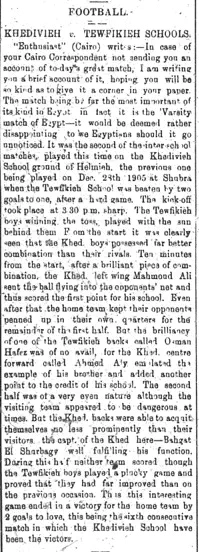The Varsity Match of Egypt
 Article on the Football match
Article on the Football matchOn Monday, March 5th, 1906, the Egyptian Gazette posted an article about football in their “Sport and Play” section. An “enthusiast” sent in the article of the summary of this football game hoping that the Egyptian Gazette would be kind enough as to give this “enthusiast’s” article a corner of the paper.
When this article was made in 1906, football was one of the the most popular sports in Egypt. Egyptians would use to gather around to watch their various clubs play, including the Egyptian national football team, almost on a daily basis. No matter what level of play it was, football was a big deal wherever it was played in Egypt. There were many other sports in Egypt, including polo, which was another popular sport in the Middle East, but football, at the time, stood out amongst all of them.
The match that was being played was referred to as the “Varsity match of Egypt”. It is one of the most important football matches in Egypt played between Khedivieh and Tewfikieh Schools. This was the first inter-school match played between the teams since December 28th, 1905, with Khedivieh beating Tewfikieh School two goals to one. The Khedivial and Tewfikieh Schools were two secondary schools that had a long standing rivalry in football. There were other secondary schools in Upper Egypt, including Girgeh, Ketieh, and Assouan.
The Tewfikieh boys won the coin toss, but ten minutes into the game, Mahmoud Ali, left wing for Khedivial, scored for the first point of the game. Then, near the end of the first half, the Khedivial centre forward, Ahmed Aly, who is the brother of the player that scored the first goal, added another point for his team to make the score two goals to love.
The whole second half was pretty even, as the Khedivial boys topped their rivals two goals to love. This was the 6th consecutive match that the Khedivial School have ended up as the victors.